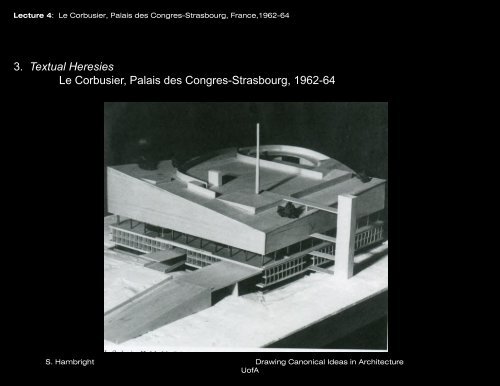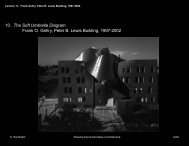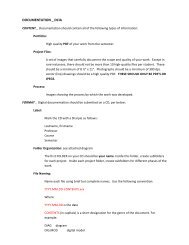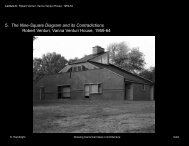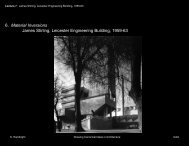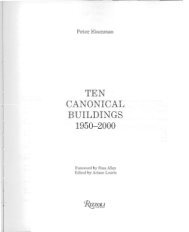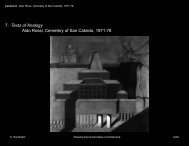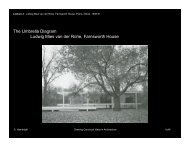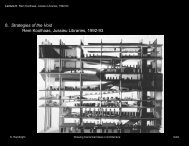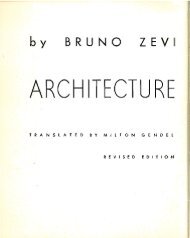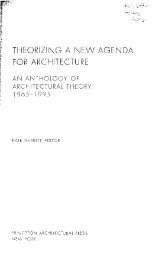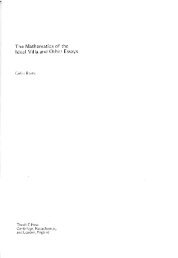3. Textual Heresies Le Corbusier, Palais des Congres-Strasbourg ...
3. Textual Heresies Le Corbusier, Palais des Congres-Strasbourg ...
3. Textual Heresies Le Corbusier, Palais des Congres-Strasbourg ...
You also want an ePaper? Increase the reach of your titles
YUMPU automatically turns print PDFs into web optimized ePapers that Google loves.
<strong>Le</strong>cture 4: <strong>Le</strong> <strong>Corbusier</strong>, <strong>Palais</strong> <strong>des</strong> <strong>Congres</strong>-<strong>Strasbourg</strong>, France,1962-64<br />
<strong>3.</strong> <strong>Textual</strong> <strong>Heresies</strong><br />
<strong>Le</strong> <strong>Corbusier</strong>, <strong>Palais</strong> <strong>des</strong> <strong>Congres</strong>-<strong>Strasbourg</strong>, 1962-64<br />
S. Hambright Drawing Canonical Ideas in Architecture<br />
UofA
<strong>Le</strong>cture 4: <strong>Le</strong> <strong>Corbusier</strong>, <strong>Palais</strong> <strong>des</strong> <strong>Congres</strong>-<strong>Strasbourg</strong>, France,1962-64<br />
“This drawing is an early manifestation of what was to become an evolving obsession: the<br />
dialectical and tensioned interplay of the figure with the Cartesian grid, which appears in his<br />
earliest Purist paintings and continues throughout his career, evolving from a two-dimensional<br />
figures to three-dimensional figures.”<br />
<strong>Le</strong> <strong>Corbusier</strong>, Sketch of Parthenon<br />
Can you see the figural / Cartesian elements in the<br />
drawing to the left?<br />
S. Hambright Drawing Canonical Ideas in Architecture<br />
UofA
<strong>Le</strong>cture 4: <strong>Le</strong> <strong>Corbusier</strong>, <strong>Palais</strong> <strong>des</strong> <strong>Congres</strong>-<strong>Strasbourg</strong>, France,1962-64<br />
Francis Bacon<br />
According to Eisenman, what is the difference between figuration and figural?<br />
“…the human figure no longer presents itself as a discrete, clear form, but rather resi<strong>des</strong> in<br />
what can be called an undecidable relationship with the canvas...”<br />
S. Hambright Drawing Canonical Ideas in Architecture<br />
UofA
<strong>Le</strong>cture 4: <strong>Le</strong> <strong>Corbusier</strong>, <strong>Palais</strong> <strong>des</strong> <strong>Congres</strong>-<strong>Strasbourg</strong>, France,1962-64<br />
Maison Dom-ino, 1914<br />
Can you see the cartesian and figured elements in the two images above?<br />
Still Life<br />
1920<br />
“If cubist painting was marked by a tension between the frontal picture plane and spatial depth,<br />
<strong>Le</strong> <strong>Corbusier</strong>’s architecture strained to both incorporate and overcome the tenets of frontal and<br />
flattened cubist space in a three-dimensional matrix.”<br />
S. Hambright Drawing Canonical Ideas in Architecture<br />
UofA
<strong>Le</strong>cture 4: <strong>Le</strong> <strong>Corbusier</strong>, <strong>Palais</strong> <strong>des</strong> <strong>Congres</strong>-<strong>Strasbourg</strong>, France,1962-64<br />
Maison Dom-ino, 1914<br />
What does Eisenman mean when he says ‘critique of architecture’s relationship to the ground?”<br />
<strong>Le</strong> <strong>Corbusier</strong>’s 5 Points<br />
Free plan<br />
Free façade<br />
Roof garden<br />
Pilotis<br />
Ribbon windows<br />
“The primitive foundation blocks in the place of pilotis initiate a critique of architecture’s<br />
relationship to the ground...”<br />
S. Hambright Drawing Canonical Ideas in Architecture<br />
UofA
<strong>Le</strong>cture 4: <strong>Le</strong> <strong>Corbusier</strong>, <strong>Palais</strong> <strong>des</strong> <strong>Congres</strong>-<strong>Strasbourg</strong>, France,1962-64<br />
Giambattista Nolli, The Nolli Map, 1748, Rome, Italy<br />
Think about the figure/ground relationship in these drawings.<br />
“…figure in architecture had always been tied to the ground, so much so that it was defined as a<br />
figure/ground relationship.”<br />
S. Hambright Drawing Canonical Ideas in Architecture<br />
UofA
<strong>Le</strong>cture 4: <strong>Le</strong> <strong>Corbusier</strong>, <strong>Palais</strong> <strong>des</strong> <strong>Congres</strong>-<strong>Strasbourg</strong>, France,1962-64<br />
<strong>Le</strong> <strong>Corbusier</strong>, Villa Savoy, 1927-30, Poissy, France<br />
Can you see the ‘figured condition in the circulation” in the right sketch?<br />
“…develop the diagram offered in his ‘Five Points,’ and introduce a more strongly figured<br />
condition in the circulation.”<br />
S. Hambright Drawing Canonical Ideas in Architecture<br />
UofA
<strong>Le</strong>cture 4: <strong>Le</strong> <strong>Corbusier</strong>, <strong>Palais</strong> <strong>des</strong> <strong>Congres</strong>-<strong>Strasbourg</strong>, France,1962-64<br />
Vila Savoy, 1927-30, Poissy, France<br />
“The ramp as a figured element creates and registers a kind of vortex of centrifugal energy.”<br />
S. Hambright Drawing Canonical Ideas in Architecture<br />
UofA
<strong>Le</strong>cture 4: <strong>Le</strong> <strong>Corbusier</strong>, <strong>Palais</strong> <strong>des</strong> <strong>Congres</strong>-<strong>Strasbourg</strong>, France,1962-64<br />
<strong>Le</strong> <strong>Corbusier</strong>, Villa Stein, Garches,<br />
1927-30<br />
Can you see the dialectical relationship Eisenman is discussing?<br />
“In these early works, the figured elements are implicated in a dialectical relationship to the<br />
abstract grid of the buildings’ plan, faca<strong>des</strong>, and section.”<br />
S. Hambright Drawing Canonical Ideas in Architecture<br />
UofA
<strong>Le</strong>cture 4: <strong>Le</strong> <strong>Corbusier</strong>, <strong>Palais</strong> <strong>des</strong> <strong>Congres</strong>-<strong>Strasbourg</strong>, France,1962-64<br />
<strong>Le</strong> <strong>Corbusier</strong>, Villa Stein, Garches, France, 1927-30<br />
“In these early works, the figured elements are implicated in a dialectical relationship to the<br />
abstract grid of the buildings’ plan, faca<strong>des</strong>, and section.”<br />
S. Hambright Drawing Canonical Ideas in Architecture<br />
UofA
<strong>Le</strong>cture 4: <strong>Le</strong> <strong>Corbusier</strong>, <strong>Palais</strong> <strong>des</strong> <strong>Congres</strong>-<strong>Strasbourg</strong>, France,1962-64<br />
Ronchamp, France, 1950<br />
How are these buildings fundamentally different from <strong>Corbusier</strong>’s earlier work?<br />
Philips Pavilion, Belgium, 1958 Chandigarh, India, 1953-65<br />
“In Ronchamp, the Philips Pavilion, and Chandigarh, fully three-dimensional figures stand out<br />
against the grid, yet the grid remains legible.”<br />
S. Hambright Drawing Canonical Ideas in Architecture<br />
UofA
<strong>Le</strong>cture 4: <strong>Le</strong> <strong>Corbusier</strong>, <strong>Palais</strong> <strong>des</strong> <strong>Congres</strong>-<strong>Strasbourg</strong>, France,1962-64<br />
<strong>Le</strong> <strong>Corbusier</strong>, Ronchamp, 1950<br />
“The square punctures in the façade register a tension between an implied vertical grid and the<br />
sloping wall, as if the holes were tethers maintaining the wall’s curve.”<br />
S. Hambright Drawing Canonical Ideas in Architecture<br />
UofA
<strong>Le</strong>cture 4: <strong>Le</strong> <strong>Corbusier</strong>, <strong>Palais</strong> <strong>des</strong> <strong>Congres</strong>-<strong>Strasbourg</strong>, France,1962-64<br />
<strong>Le</strong> <strong>Corbusier</strong>, Ronchamp, France,1950<br />
“The square punctures in the façade register a tension between an implied vertical grid and the<br />
sloping wall, as if the holes were tethers maintaining the wall’s curve.”<br />
S. Hambright Drawing Canonical Ideas in Architecture<br />
UofA
<strong>Le</strong>cture 4: <strong>Le</strong> <strong>Corbusier</strong>, <strong>Palais</strong> <strong>des</strong> <strong>Congres</strong>-<strong>Strasbourg</strong>, France,1962-64<br />
<strong>Le</strong> <strong>Corbusier</strong>, Parliament Building at Chandigarh, 1953-65<br />
Consider the different figures in the building above.<br />
“If the prewar work demonstrates the linear figure becoming increasingly three-dimensional, it<br />
could be argued that <strong>Le</strong> <strong>Corbusier</strong>’s postwar work begins with the fully articulated figure, which<br />
is increasingly deformed into a series of partial figures.”<br />
S. Hambright Drawing Canonical Ideas in Architecture<br />
UofA
<strong>Le</strong>cture 4: <strong>Le</strong> <strong>Corbusier</strong>, <strong>Palais</strong> <strong>des</strong> <strong>Congres</strong>-<strong>Strasbourg</strong>, France,1962-64<br />
<strong>Le</strong> <strong>Corbusier</strong>, Villa Stein (1927-30) and Parliament<br />
Building at Chandigarh (1953-65)<br />
How are the faca<strong>des</strong> similar above? How do the faca<strong>des</strong> differ? What are the different readings you can pull from the two?<br />
“…departure from the planar, free façade...’”<br />
S. Hambright Drawing Canonical Ideas in Architecture<br />
UofA
<strong>Le</strong>cture 4: <strong>Le</strong> <strong>Corbusier</strong>, <strong>Palais</strong> <strong>des</strong> <strong>Congres</strong>-<strong>Strasbourg</strong>, France,1962-64<br />
<strong>Le</strong> <strong>Corbusier</strong>, Chandigarh, Harvard’s Carpenter Center, and La Tourette<br />
“…departure from the planar, free façade...’”<br />
S. Hambright Drawing Canonical Ideas in Architecture<br />
UofA
<strong>Le</strong>cture 4: <strong>Le</strong> <strong>Corbusier</strong>, <strong>Palais</strong> <strong>des</strong> <strong>Congres</strong>-<strong>Strasbourg</strong>, France,1962-64<br />
<strong>Le</strong> <strong>Corbusier</strong>, La Tourette, France,1950-60<br />
Can you see the rotational energy?<br />
“La Tourette can also be related to <strong>Strasbourg</strong> by means of a rotational energy established by<br />
the pinwheeling organization of its lower floors.’”<br />
S. Hambright Drawing Canonical Ideas in Architecture<br />
UofA
<strong>Le</strong>cture 4: <strong>Le</strong> <strong>Corbusier</strong>, <strong>Palais</strong> <strong>des</strong> <strong>Congres</strong>-<strong>Strasbourg</strong>, France,1962-64<br />
<strong>Le</strong> <strong>Corbusier</strong>, La Tourette, France,1950-60<br />
“La Tourette can also be related to <strong>Strasbourg</strong> by means of a rotational energy established by<br />
the pinwheeling organization of its lower floors.’”<br />
S. Hambright Drawing Canonical Ideas in Architecture<br />
UofA
<strong>Le</strong>cture 4: <strong>Le</strong> <strong>Corbusier</strong>, <strong>Palais</strong> <strong>des</strong> <strong>Congres</strong>-<strong>Strasbourg</strong>, France,1962-64<br />
<strong>Palais</strong> <strong>des</strong> <strong>Congres</strong><br />
What are the centrifugal forces in this drawing, or how are<br />
they evident?<br />
Can someone point out a drawing in the chapter that gives<br />
the sense of centripetal?<br />
“Unlike the rotation on the entry façade of La Tourette…the rotation developed at <strong>Strasbourg</strong> is<br />
no longer dialectical with respect to any frontal plane, but rather registers simultaneously as<br />
centripetal and centrifugal in plan and section.”<br />
S. Hambright Drawing Canonical Ideas in Architecture<br />
UofA
<strong>Le</strong>cture 4: <strong>Le</strong> <strong>Corbusier</strong>, <strong>Palais</strong> <strong>des</strong> <strong>Congres</strong>-<strong>Strasbourg</strong>, France,1962-64<br />
La Tourette, Carpentter Center<br />
<strong>Palais</strong> <strong>des</strong> <strong>Congres</strong><br />
What of <strong>Le</strong> <strong>Corbusier</strong>’s Five Points are<br />
still evident in the Carpenter Center?<br />
“Despite the contradictory internal movements at the Carpenter Center…it could be argued that<br />
each component is articulated as a separate figure.”<br />
S. Hambright Drawing Canonical Ideas in Architecture<br />
UofA
<strong>Le</strong>cture 4: <strong>Le</strong> <strong>Corbusier</strong>, <strong>Palais</strong> <strong>des</strong> <strong>Congres</strong>-<strong>Strasbourg</strong>, France,1962-64<br />
Villa Savoy and Villa Stein<br />
Explain the statement below using the two buildings above. What is the link between a ‘diagram’ and ‘text’ for Eisenman?<br />
“The centrality of the ‘Five Points’ in <strong>Le</strong> <strong>Corbusier</strong>’s prewar work suggests that the points<br />
served as a foundational diagram from which each building draws, but inflects differently.”<br />
S. Hambright Drawing Canonical Ideas in Architecture<br />
UofA
<strong>Le</strong>cture 4: <strong>Le</strong> <strong>Corbusier</strong>, <strong>Palais</strong> <strong>des</strong> <strong>Congres</strong>-<strong>Strasbourg</strong>, France,1962-64<br />
<strong>Palais</strong> <strong>des</strong> <strong>Congres</strong><br />
“…on the one hand in its didactic refutation of each of the ‘Five Points,’ and on the other in its<br />
movement away from a dialectical relationship between figure and grid.”<br />
Pilotis<br />
S. Hambright Drawing Canonical Ideas in Architecture<br />
UofA
<strong>Le</strong>cture 4: <strong>Le</strong> <strong>Corbusier</strong>, <strong>Palais</strong> <strong>des</strong> <strong>Congres</strong>-<strong>Strasbourg</strong>, France,1962-64<br />
<strong>Palais</strong> <strong>des</strong> <strong>Congres</strong><br />
Ribbon Window<br />
“…on the one hand in its didactic refutation of each of the ‘Five Points,’ and on the other in its<br />
movement away from a dialectical relationship between figure and grid.”<br />
S. Hambright Drawing Canonical Ideas in Architecture<br />
UofA
<strong>Le</strong>cture 4: <strong>Le</strong> <strong>Corbusier</strong>, <strong>Palais</strong> <strong>des</strong> <strong>Congres</strong>-<strong>Strasbourg</strong>, France,1962-64<br />
<strong>Palais</strong> <strong>des</strong> <strong>Congres</strong><br />
Free Plan<br />
“…on the one hand in its didactic refutation of each of the ‘Five Points,’ and on the other in its<br />
movement away from a dialectical relationship between figure and grid.”<br />
S. Hambright Drawing Canonical Ideas in Architecture<br />
UofA
<strong>Le</strong>cture 4: <strong>Le</strong> <strong>Corbusier</strong>, <strong>Palais</strong> <strong>des</strong> <strong>Congres</strong>-<strong>Strasbourg</strong>, France,1962-64<br />
<strong>Palais</strong> <strong>des</strong> <strong>Congres</strong><br />
Free Façade<br />
“…on the one hand in its didactic refutation of each of the ‘Five Points,’ and on the other in its<br />
movement away from a dialectical relationship between figure and grid.”<br />
S. Hambright Drawing Canonical Ideas in Architecture<br />
UofA
<strong>Le</strong>cture 4: <strong>Le</strong> <strong>Corbusier</strong>, <strong>Palais</strong> <strong>des</strong> <strong>Congres</strong>-<strong>Strasbourg</strong>, France,1962-64<br />
Roof Garden<br />
“…on the one hand in its didactic refutation of each of the ‘Five Points,’ and on the other in its<br />
movement away from a dialectical relationship between figure and grid.”<br />
S. Hambright Drawing Canonical Ideas in Architecture<br />
UofA<br />
<strong>Palais</strong> <strong>des</strong> <strong>Congres</strong>
<strong>Le</strong>cture 4: <strong>Le</strong> <strong>Corbusier</strong>, <strong>Palais</strong> <strong>des</strong> <strong>Congres</strong>-<strong>Strasbourg</strong>, France,1962-64<br />
<strong>Palais</strong> <strong>des</strong> <strong>Congres</strong><br />
Roof Garden<br />
“…on the one hand in its didactic refutation of each of the ‘Five Points,’ and on the other in its<br />
movement away from a dialectical relationship between figure and grid.”<br />
S. Hambright Drawing Canonical Ideas in Architecture<br />
UofA
<strong>Le</strong>cture 4: <strong>Le</strong> <strong>Corbusier</strong>, <strong>Palais</strong> <strong>des</strong> <strong>Congres</strong>-<strong>Strasbourg</strong>, France,1962-64<br />
<strong>Palais</strong> <strong>des</strong> <strong>Congres</strong> Third Floor <strong>Palais</strong> <strong>des</strong> <strong>Congres</strong> Fourth and Fifth Floors<br />
Eisenman says that <strong>Corbusier</strong>s postwar work questions the ‘wholeness’ of the figure. What does this mean? Where do you see<br />
this at <strong>Palais</strong> <strong>des</strong> <strong>Congres</strong>-<strong>Strasbourg</strong>?<br />
S. Hambright Drawing Canonical Ideas in Architecture<br />
UofA
<strong>Le</strong>cture 4: <strong>Le</strong> <strong>Corbusier</strong>, <strong>Palais</strong> <strong>des</strong> <strong>Congres</strong>-<strong>Strasbourg</strong>, France,1962-64<br />
How is the figure/ground relationship inverted?<br />
La Tourette, France<br />
<strong>Palais</strong> <strong>des</strong> <strong>Congres</strong><br />
“…many of the relationships established in La Tourette and the Carpenter Center are inverted.”<br />
S. Hambright Drawing Canonical Ideas in Architecture<br />
UofA
<strong>Le</strong>cture 4: <strong>Le</strong> <strong>Corbusier</strong>, <strong>Palais</strong> <strong>des</strong> <strong>Congres</strong>-<strong>Strasbourg</strong>, France,1962-64<br />
Chandigarh, India<br />
<strong>Palais</strong> <strong>des</strong> <strong>Congres</strong><br />
How is the figure/ground relationship inverted?<br />
“…many of the relationships established in La Tourette and the Carpenter Center are inverted.”<br />
S. Hambright Drawing Canonical Ideas in Architecture<br />
UofA
<strong>Le</strong>cture 4: <strong>Le</strong> <strong>Corbusier</strong>, <strong>Palais</strong> <strong>des</strong> <strong>Congres</strong>-<strong>Strasbourg</strong>, France,1962-64<br />
Chandigarh, India<br />
How is the free plan/ free façade relationship inverted?<br />
La Tourette, France<br />
“…many of the relationships established in La Tourette and the Carpenter Center are inverted.”<br />
S. Hambright Drawing Canonical Ideas in Architecture<br />
UofA<br />
<strong>Palais</strong> <strong>des</strong> <strong>Congres</strong>
<strong>Le</strong>cture 4: <strong>Le</strong> <strong>Corbusier</strong>, <strong>Palais</strong> <strong>des</strong> <strong>Congres</strong>-<strong>Strasbourg</strong>, France,1962-64<br />
Carpenter Center<br />
How is the surface of the roof garden relationship inverted?<br />
<strong>Palais</strong> <strong>des</strong> <strong>Congres</strong><br />
“…many of the relationships established in La Tourette and the Carpenter Center are inverted.”<br />
S. Hambright Drawing Canonical Ideas in Architecture<br />
UofA
<strong>Le</strong>cture 4: <strong>Le</strong> <strong>Corbusier</strong>, <strong>Palais</strong> <strong>des</strong> <strong>Congres</strong>-<strong>Strasbourg</strong>, France,1962-64<br />
Carpenter Center<br />
How is the circulation relationship inverted?<br />
<strong>Palais</strong> <strong>des</strong> <strong>Congres</strong><br />
“…many of the relationships established in La Tourette and the Carpenter Center are inverted.”<br />
S. Hambright Drawing Canonical Ideas in Architecture<br />
UofA
<strong>Le</strong>cture 4: <strong>Le</strong> <strong>Corbusier</strong>, <strong>Palais</strong> <strong>des</strong> <strong>Congres</strong>-<strong>Strasbourg</strong>, France,1962-64<br />
La Tourette, France<br />
How is the circulation relationship inverted?<br />
<strong>Palais</strong> <strong>des</strong> <strong>Congres</strong><br />
“…many of the relationships established in La Tourette and the Carpenter Center are inverted.”<br />
S. Hambright Drawing Canonical Ideas in Architecture<br />
UofA
<strong>Le</strong>cture 4: <strong>Le</strong> <strong>Corbusier</strong>, <strong>Palais</strong> <strong>des</strong> <strong>Congres</strong>-<strong>Strasbourg</strong>, France,1962-64<br />
<strong>Palais</strong> <strong>des</strong> <strong>Congres</strong><br />
Can you explain how <strong>Strasbourg</strong> is a departure from the grid/figure dialectic?<br />
“The figure assumes a different role at <strong>Strasbourg</strong> in that it is no longer defined in relationship<br />
to the grid.”<br />
S. Hambright Drawing Canonical Ideas in Architecture<br />
UofA
<strong>Le</strong>cture 4: <strong>Le</strong> <strong>Corbusier</strong>, <strong>Palais</strong> <strong>des</strong> <strong>Congres</strong>-<strong>Strasbourg</strong>, France,1962-64<br />
Farnsworth House<br />
What does Eisenman mean by ‘breaching the container?’<br />
<strong>Palais</strong> <strong>des</strong> <strong>Congres</strong><br />
“The subject becomes involved not only in the figural ramp but also in the breaching of the<br />
container...”<br />
S. Hambright Drawing Canonical Ideas in Architecture<br />
UofA
<strong>Le</strong>cture 4: <strong>Le</strong> <strong>Corbusier</strong>, <strong>Palais</strong> <strong>des</strong> <strong>Congres</strong>-<strong>Strasbourg</strong>, France,1962-64<br />
<strong>Palais</strong> <strong>des</strong> <strong>Congres</strong><br />
“…the object is no longer merely contained in the volumetric enclosure but rather a series of<br />
forces push the object out through the exterior enclosure of the object, while the movement of<br />
the subject continues to circumscribe the volume.”<br />
S. Hambright Drawing Canonical Ideas in Architecture<br />
UofA
<strong>Le</strong>cture 4: <strong>Le</strong> <strong>Corbusier</strong>, <strong>Palais</strong> <strong>des</strong> <strong>Congres</strong>-<strong>Strasbourg</strong>, France,1962-64<br />
Villa Savoy, France<br />
<strong>Palais</strong> <strong>des</strong> <strong>Congres</strong><br />
“<strong>Strasbourg</strong> shifts the idea of understanding from seeing to the experience of movement.”<br />
S. Hambright Drawing Canonical Ideas in Architecture<br />
UofA
<strong>Le</strong>cture 4: <strong>Le</strong> <strong>Corbusier</strong>, <strong>Palais</strong> <strong>des</strong> <strong>Congres</strong>-<strong>Strasbourg</strong>, France,1962-64<br />
<strong>Palais</strong> <strong>des</strong> <strong>Congres</strong><br />
“What becomes visible in the <strong>Strasbourg</strong> project as a pivotal development of <strong>Le</strong> <strong>Corbusier</strong>’s<br />
thought is the new figural condition of the subject’s experience of the object.”<br />
S. Hambright Drawing Canonical Ideas in Architecture<br />
UofA
<strong>Le</strong>cture 4: <strong>Le</strong> <strong>Corbusier</strong>, <strong>Palais</strong> <strong>des</strong> <strong>Congres</strong>-<strong>Strasbourg</strong>, France,1962-64<br />
Maison Dom-ino<br />
<strong>Palais</strong> <strong>des</strong> <strong>Congres</strong><br />
Koolhaas, Il Jussieu Library Competition<br />
“This building offers a missing link between the formal strategies of the high modernist ‘Five<br />
Points’ and those apparent in Rem Koolhaas’s Tres Grande Bibliotheque and Jussieu<br />
Libraries.”<br />
S. Hambright Drawing Canonical Ideas in Architecture<br />
UofA
<strong>Le</strong>cture 4: <strong>Le</strong> <strong>Corbusier</strong>, <strong>Palais</strong> <strong>des</strong> <strong>Congres</strong>-<strong>Strasbourg</strong>, France,1962-64<br />
Koolhaas, Il Jussieu Library Competition<br />
<strong>Palais</strong> <strong>des</strong> <strong>Congres</strong><br />
“The discontinuity between successive horizontal plan levels at <strong>Strasbourg</strong> will ultimately<br />
appear in Koolhaas’s Delirious New York and his French library projects.”<br />
S. Hambright Drawing Canonical Ideas in Architecture<br />
UofA<br />
Koolhaas, New York Athletic Club


